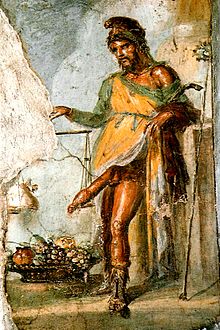Priapus
In Greek mythology, Priapus was a minor rustic fertility god, protector of livestock, fruit plants, gardens, and male genitalia. Priapus is marked by his oversized, permanent erection, which gave rise to the medical term priapism. He became a popular figure in Roman erotic art and Latin literature and is the subject of the often humorously obscene collection of verse called the Priapeia (see below).
Patron of merchant sailing
Priapus' role as a patron god for merchant sailors in ancient Greece and Rome is that of a protector and navigational aide. Recent shipwreck evidence contains apotropaic items carried onboard by mariners in the forms of a terracotta phallus, wooden Priapus figure, and bronze sheath from a military ram. Coinciding with the use of wooden Priapic markers erected in areas of dangerous passage or particular landing areas for sailors, the function of Priapus is much more extensive than previously thought.
Although Priapus is commonly associated with the failed attempts of rape against the nymphs Lotis and Vesta in Ovid’s comedy Fasti and the rather flippant treatment of the deity in urban settings, Priapus' protection traits can be traced back to the importance placed on the phallus in ancient times (particularly his association with fertility and garden protection). In Greece, the phallus was thought of to have a mind of its own, animal-like, separate from the mind and control of the man. The phallus is also associated with "possession and territorial demarcation" in many cultures, attributing to Priapus' other role as a navigational deity.
Priapism
Priapism is a potentially painful medical condition in which the erect penis does not return to its flaccid state, despite the absence of both physical and psychological stimulation, within four hours. Priapism is considered a medical emergency, which should receive proper treatment by a qualified medical practitioner. There are two types of priapism: low-flow (ischemic) and high-flow (nonischemic); 80% to 90% of clinically presented priapisms are low-flow disorders. Low-flow involves the blood not adequately returning to the body from the penis. High-flow involves a short-circuit of the vascular system partway along the penis. Treatment is different for each type. Early treatment can be beneficial for functional recovery.
Not all sources give four hours as the guideline for priapism occurring: "The duration time of a normal erection before it is classifiable as priapism is still controversial. Ongoing penile erections for more than 6 hours can be classified as priapism."
Priapeia
The name comes from the Greek god Priapus (Ancient Greek: Π"ίαπος), a fertility god often represented with a disproportionately large and permanent erection.
Percidere, puer, moneo; futuere, puella;
- barbatum furem tertia poena manet.
Femina si furtum faciet mihi virve puerve,
- haec cunnum, caput hic praebeat, ille nates.
Per medios ibit pueros mediasque puellas
- mentula, barbatis non nisi summa petet.
I warn you, boy, you will be screwed; girl, you will be fucked;
- a third penalty awaits the bearded thief.
If a woman steals from me, or a man, or a boy,
- let the first give me her cunt, the second his head, the third his buttocks.
My dick will go through the middle of boys and the middle of girls,
- but with bearded men it will aim only for the top.[1]
Chat rooms • What links here • Copyright info • Contact information • Category:Root
